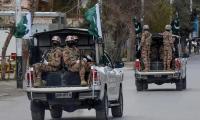Swat today cannot be recognized through the lens of the past. Businesses of Swatis are flourishing and tourism is increasing. Expressways are linking the valley with motorways. All the schools which were destroyed and burnt by the militants have been reconstructed, much better than before. It is the army which stood with the people in all odds like floods, earthquakes as well as in fighting militancy and the people of Swat cherish this asset. Beheadings of common people, kidnappings for ransom, abduction of women, robbing private properties, attacks on security forces personnel, interference in government functions and other terrorist activities are memories of the past thanks to the army. Swat today stands smiling.
The militancy in Swat was tackled through an operation in 2009. The operation was necessitated following barbaric practices adopted by Maulvi Fazlullah, the son-in-law of Sufi Muhammad, and his cohorts.
As it is, the people of the area and throughout Pakistan supported the armed forces in the operation that countered the TTP and its obnoxious practices of vengeful nature that had nothing to do with the religion. Also, the political parties in the country through an all-parties conference (APC) pledged to unite the nation against insurgency and terrorism in these regions. Within three months, Pakistan’s armed forces successfully tackled the threat posed by the foreign-funded and Indian RAW sponsored terrorists in Buner, Dir, Swat and other adjoining areas and successfully ejected them.
Needless to say the Pakistani armed forces fought valiantly against the zealous and fanatical gunmen and terrorists and ended their reign from the areas, eliminating their roots. The foreign war colleges have studied the Swat battle and have been struck by the professionalism of the operation. The quick win in the new kind of warfare was highly acclaimed. New tactics were used in the asymmetric warfare, which led to enriching the experiences of the battle-hardened Pakistani forces, which further developed and refined the capacity to counter foreign state-sponsored campaign of terror attacks.
The case study of militancy in Swat reveals inequalities and inaction that could have stopped terrorism in its tracks. The government of that day failed to address the grievances of the people, who sought policing independent of political influence, quick justice system, strong and resourceful institutions, realization of local concerns and strong weapon control system. However, once the militancy had erupted, the most important requirement was a clearheaded and timely decision whether to launch an operation or not. If the governments in the province and the Centre would have taken an in-time decision for a military operation, big losses that were later faced by the people could have been avoided. Thus Swat’s case should offer us a future path correction elsewhere, if there is such a requirement.
After the terrorist capabilities in the area were totally eliminated, as a gift for the resilient people of Swat, an Army Public School and College with the capacity of 3,600 students was the first project of the cantonment in Swat. While inaugurating the state-of-the-art facility, COAS General Qamar Javed Bajwa declared it as one of the best Army Public Schools in the entire country.
The successful operation has clearly demonstrated the nation’s commitment and strategic intent to regional peace and stability. Strategic threat to national security has to be forcefully countered, aggression of terrorist outfits has to be pre-empted and that military operations are not won by good defences.
Legendary poetess Parveen Shakir. — APP/FileIslamabad: The Parveen Shakir Trust will observe the 30th death...
Coordinator General of COMSTECH Prof Dr Muhammad Iqbal Choudhary seen in a meeting on the launch of the “COMSTECH...
Children seen at the 'Bookshaw' session for children and a health camp for mothers and babies organised by Association...
Fatima Jinnah Women’s University building can be seen. — ILM Website/FileRawalpindi: Fatima Jinnah Women...
A general view of the Margalla Hills Islamabad can be seen in this image. — Facebook/Islamabad Wildlife Management...
A picture from an exhibition based on rare pictures of Quaid-e-Azam inaugurated by Assistant Commissioner Murree on...







